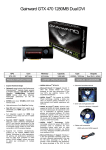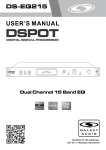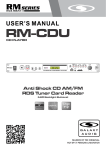Download manual - Galaxy Audio
Transcript
DHTRQUAD UHF USER'S MANUAL ® WIRELESSMICROPHONESYSTEM ANYSPOT ® ® DHTRQUAD UHF Four Channel Diversity Wireless Receiver IR POWER SYNC MAKERS OF THE ORIGINAL HOT SPOT PERSONAL MONITOR Contents System Components..........................................1 Rack-Mounting the Receiver...............................2 HH64/HH64SC Handheld Transmitter.................3 MBP64 Bodypack Transmitter.............................4 MBP76 Bodypack Transmitter.............................5 SM-W76 Wireless Shockmount Base..................6 System Setup.....................................................7 Setting up multiple receivers...............................8 Functions of the DHTRQUAD Receiver................9 Troubleshooting.................................................10 Specifications....................................................11 Accessories and Replacement Parts.........................12 DHTRQUAD Frequency Chart....................................13 DHTRQUAD System DHTRQUAD System Thank you for purchasing the DHTRQUAD wireless system. For users who need an advanced UHF wireless system, the DHTRQUAD provides an excellent solution. With 120 selectable channels, the DHTRQUAD is perfect for applications such as live shows, broadcast, meetings, & musical instruments. Touch buttons and liquid crystal displays allow for a quick and simple system setup. The "User Guide"and" Quick Setting Guide" included in your system will provide all the details you need to operate the system efficiently. Frequency Band Most countries closely regulate the radio frequencies used in the transmission of wireless information. These regulations state which devises can use which frequencies, and help to limit the amount of RF (radio frequency) interference in all wireless communications. The DHTRQUAD offers 120 selectable channels within either the 584-607MHz (Code D) or 655-679MHz (Code L) frequency ranges. To facilitate system setup and protect against RF interference, each system comes with multiple predefined frequency groups and channels. When using a single receiver/transmitter, the operating frequency will generally not have to be changed. In an installation with multiple receivers/transmitters, each set must operate on a separate channel from the others. The group and channel system provides an optimum frequency spread when using multiple receiver/transmitter systems. System Components All systems include: ANYSPOT ® ® DHTRQUAD UHF Four Channel Diversity Wireless Receiver IR POWER DHTRQUAD Receiver ¼" to ¼" Audio Cable Power Supply Two Antennas Extension Kit Rack Ears User Guide SYNC O N CHANNEL BATT O F INFRARED Transmitter Options: HH64 / HH64SC Handheld Mic/Transmitter SM-W76 Wireless Shockmount Base Visit our website www.galaxyaudio.com to see all of our great headset & lavalier options LAMP POWER BATT GROUP CHANNEL ASC MBP64 MBP64 Body Pack Transmitter MBP76 Body Pack Transmitter 1 Rack-Mounting the Receiver Rack-Mounting the Receiver Maintain a line of sight between transmitter and antenna. Panel mount BNC feed-through connectors CN-BNCPM Antenna Extension Cable EXTBNC Rack Ears MREDHTQUAD ANYSPOT ® ® DHTRQUAD UHF Four Channel Diversity Wireless Receiver IR SYNC POWER ANT-DISTDC ANYSPOT ® Shown with optional ANT-DISTDC antenna distributor. ® UHF ANTENNA DISTRIBUTOR POWER ANYSPOT ® ® DHTRQUAD UHF Four Channel Diversity Wireless Receiver IR SYNC POWER ANYSPOT ® ® DHTRQUAD UHF Four Channel Diversity Wireless Receiver IR SYNC POWER ANYSPOT ® ® DHTRQUAD UHF Four Channel Diversity Wireless Receiver ANT-DISTDC Info IR SYNC POWER ANYSPOT ® ® DHTRQUAD UHF Four Channel Diversity Wireless Receiver Four DHTRQUAD receivers IR SYNC POWER The ANT-DISTDC will provide DC power to operate up to 4 DHTRQUAD Receivers. ANT-DISTDC ANT-1 ANTENNA-B DC IN ANT-2 ANT-3 M H Antenna-B M L H Channel 4 XLR balanced SQL H Channel 4 XLR balanced H Channel 4 XLR balanced Ten BNC connecting cables (included) Two BNC connectors (included) 2 H Channel 4 XLR balanced H Channel 4 XLR balanced ANT-8 ANTENNA-A Channel 1 XLR balanced 4 in 1 Mix Unbal output 8 in 1 Mix XLR balanced Antenna-B Channel 1 XLR balanced 4 in 1 Mix Unbal output 8 in 1 Mix XLR balanced Antenna-B Channel 1 XLR balanced 4 in 1 Mix Unbal output 8 in 1 Mix XLR balanced Antenna-B Channel 1 XLR balanced 4 in 1 Mix Unbal output 8 in 1 Mix XLR balanced Antenna-B L SQL M L SQL ANT-7 M L SQL H Channel 4 XLR balanced ANT-6 L SQL M L SQL ANT-5 M L H Channel 4 XLR balanced 12~18 3000mA L SQL M L H Channel 4 XLR balanced H Channel 4 XLR balanced SQL M L SQL H Channel 4 XLR balanced SQL M H Antenna-B OUTPUT4 600mA M L SQL M L SQL OUTPUT3 600mA M L SQL M H Antenna-B H Channel 4 XLR balanced M L SQL OUTPUT2 600mA M L SQL M H Antenna-B OUTPUT1 600mA ANT-4 H Channel 4 XLR balanced L SQL 1. BNC Cables 2. Power Supply Cable HH64/HH64SC Handheld Transmitter Functions: 2 1 GROUP CHANNEL BATT INFRARED 1 Condensor mic 2 Dynamic mic 3 LCD screen Please See “system setup ” on page 8. 4 Power Switch 5 Microphone Input Sensitivity Control. Left turn for output level decrease, right turn for output level increase. 6 IR Port receives infrared beam to synchronize frequencies. 3 4 5 6 Changing Batteries: GROUP CHANNEL BATT INFRARED Batteries should be replaced when LCD indicator flashes. Unscrew the battery cover as shown below. Install two AA alkaline batteries, while observing correct polarity indicators in the battery tray. Expected life for two AA alkaline batteries is 8 hours. 3 MBP64 Bodypack Transmitter BodyPack Transmitter 1 1 Antenna. 2 Gain Switch. There are three Gain settings on the MBP64. Select the setting most suitable to your application. Mic: Microphone Level 0: Guitar Level -10dB: Line Level 3 Low Voltage/IR Transmission LED. LED On: Battery Voltage OK. LED Off: the Battery Voltage is Low. Flashing LED: IR transmission is in progress 4 3-pin Input Jack. 5 Power/Backlight Control button Press and Hold for Power On/Off. Press and Release for Back-light On/Off. 6 ASC Frequency Synchronization Button. Press this button to automatically set the Transmitter frequency to match that of the Receiver. Use in conjunction with Receiver’s ASC control. 7 LCD screen See “system setup” on page 8. 8 IR Window Point this window towards IR window on Receiver during ASC frequency synchronization. 4 3 2 Functions: LAMP POWER 5 BATT 6 ASC 7 8 + + - 10 How to Wear the Bodypack Transmitter: 9 + + - + + - Slide the transmitter clip onto the belt 9 or run a guitar strap through the transmitter clip 10 , as shown in the diagram at left. Battery Replacement : The life expectancy of two alkaline batteries is about six hours. When the BATT indication symbol on the display screen is flashing as shown in the diagram below, the batteries should be replaced immediately, as shown in the diagram on the left. BATT Open Close 4 GROUP CHANNEL MBP76 Bodypack Transmitter Features 1 1 Antenna. 2 LCD panel. Please see (System Setup) on Page 7. 3 Power/ASC/ Low Battery Indicator. Constant Green: Power ON. Flashing Green: IR ASC in progress, or Low Batteries. 4 Mute Indicator. Constant Red: Audio Muted. 5 Power/Mute Button. Push and Hold for Power On/Off. Push once for Mute On/Off. 6 IR Window. Receives IR signals (ASC) to synchronize with Receiver. 7 Select Button. Please see (System Setup) on Page 8. 8 3-pin Microphone Input Jack. 9 Gain Adjustment Switch. Three gain settings are available. Choose the appropriate setting for your application: Mic: Microphone 0dB: Guitar with passive pickups -10dB: Guitar with active pickups, or Line Level Signals. 2 3 5 6 4 7 select 9 8 Note: To prevent accidental power or mute changes during a performance, you may set the Lock function by a simultaneous press and release of buttons 5 and 7. This will disable all buttons and a “lock” icon will appear in the LCD. Repeat procedure to return to normal operation. 11 10 Wearing the Backpack Transmitter: Clip the transmitter to a belt 10. For best results, slide the transmitter down until the belt is pressed against the base of the clip. Or, slide a guitar strap through the transmitter clip 11 ,as shown. Changing batteries: Open Close Expected life for Two Alkaline batteries is approximately 6 hours. Replace batteries when the Green Power LED and the LCD Battery Indicator (shown below) begin to blink. 5 SM-W76 Wireless Shockmount Base 1. Adjust the 16 position rotary knob on the rear of the SM-W76 base to change the frequency. A small flat headed screwdriver can be used. 2. Use the chart to set up the DHTR/TRCR Group & Channel to the frequency that corresponds to the SM-76 base. 3. Once the Group & Channel of the receiver is set, press the gray button on the top of the SM-76 base to turn the microphone on. 6 System Setup Receiver Programming GROUP CHANNEL ANTENNA MHz A B DISPLAY EXIT VOLUME AUTO GROUP MANUAL CONTROL CHANNEL SELECT CHANNEL FREQUENCY MASTER SELECT SELECT SELECT LIST 2 1 GROUP CHANNEL ANTENNA MHz A B DISPLAY EXIT VOLUME AUTO GROUP MANUAL CONTROL CHANNEL SELECT CHANNEL FREQUENCY MASTER SELECT SELECT SELECT LIST For best results when operating multiple systems, set all systems to a single group, then set each system to a unique channel within that group. CHANNEL ANTENNA MHz A B DISPLAY EXIT VOLUME AUTO GROUP MANUAL CONTROL CHANNEL SELECT CHANNEL FREQUENCY MASTER SELECT SELECT SELECT LIST 3 GROUP Press “SET”again , “MANUAL CHANNEL SELECT” will display, press or to choose the appropriate channel. Auto Frequency Finder function on the Receiver: 3 Choose “AUTO CHANNEL SELECT” by pressing “SET” once, then press or . Receiver will automatically find a clear frequency with no interference. 2 GROUP Group and Channel Selection: 1 Press “SET” button twice, “GROUP SELECT” will display, press or to choose the appropriate frequency group. Receiver Volume Setting: 4 The receiver has an electronic volume control. Press from the normal display (00 to 63) or Normal Display: 5 Frequency and Antenna A/B (RF Received). CHANNEL ANTENNA MHz A B Transmitting frequency automatic setup: DISPLAY EXIT VOLUME AUTO GROUP MANUAL CONTROL CHANNEL SELECT CHANNEL FREQUENCY MASTER SELECT SELECT SELECT LIST 4 GROUP Place the Transmitter “IR” window to face the Receiver “IR” window. Then press the “ASC” button on the desired Receiver. The Transmitter will automatically match the Receiver frequency. CHANNEL ANTENNA MHz A B DISPLAY EXIT VOLUME AUTO GROUP MANUAL CONTROL CHANNEL SELECT CHANNEL FREQUENCY MASTER SELECT SELECT SELECT LIST 5 Handheld Transmitter Bodypack Transmitter Attention: The distance between the Receiver and Transmitter IR windows should be less than 0.5m during the ASC IR setup. When setting up multiple Transmitters/Receivers, activate the ASC function of only one Transmitter and Receiver at a time. MBP76 Transmitter Status Display Battery Status: 1 Battery Status Indicators for both the Handheld and Bodypack Transmitters feature Four Level Displays. 1 Group and Channel Display: 2 After completing the ASC, both the Handheld and Bodypack Transmitters will display the Group and Channel numbers selected. 2 Normal Display: 3 Both Handheld and Bodypack Transmitters will display Group and Channel numbers as well as Battery Status. 3 7 Setting up multiple receivers 4 2 ANYSPOT ® ® DHTRQUAD UHF Four Channel Diversity Wireless Receiver IR POWER SYNC 5 11 1)Power on any pre-existing wireless systems and transmitters except the first DHT system. 2)Power on the first DHT Receiver. 3)The Control and set buttons are on the front of the receiver. 4)Press the set button until the group number flashes on the LCD screen 5)Press the up/down buttons to select group 1. 6Press the set button twice to get to the scan mode. 7)Press the up or down button. The unit will now go into scan mode. You will probably see the RF meters light up if the scan sees other transmitters. 8)When it stops scanning, it will stop on the clearest frequency, and will be flashing the frequency on the LCD screen. 9)Press the set button and it will set itself to that frequency. Do not wait to press the set button as the DHT Receiver will revert back to the original frequency, and the process will need to be restarted 10)If the unit cannot find a good frequency within group 1, start the process again scanning group 2, if that is also not clear try group 3, and so on till you get a good frequency. When the DHT Receiver has been set to a clear frequency, use the ASC feature to sync the receiver frequency to the transmitter. 11)Turn the transmitter on, aim the red infrared window on the transmitter towards the one on the receiver and press the ASC button on the front of the receiver. The transmitter will sync to the receivers frequency. If you have more DHT systems to tune follow the same procedure on each one, always leaving the previous system transmitter on. 8 Functions of the DHTRQUAD Receiver DHTRQUAD Receiver Features Front Panel ANYSPOT ® ® DHTRQUAD UHF Four Channel Diversity Wireless Receiver IR POWER 1 SYNC On/Off Switch 8 System Menu Down button Please see “ System Setup” on Page 8 2 Infrared (IR) Window 9 Antenna A Indicator 3 Audio Level Meter 4 Lights when Antenna A is active . LCD Panel 10 Antenna B Indicator Lights when Antenna B is active . 5 System Setup Button Please see “System Setup” on Page 8 6 System Menu Up button Please see “System Setup” on Page 8 7 ASC Sync Button Press to initiate IR connection between Receiver and Transmitter. Rear Panel M H Antenna-B M L SQL H Channel 4 XLR balanced M L SQL H Channel 4 XLR balanced M L SQL H Channel 4 XLR balanced L SQL Channel 1 XLR balanced 1 Antenna Jack B 2 Channel 4 Fine Adjustment of Squelch Threshold Level 3 Channel 4 XLR Output Jack 4 in 1 Mix Unbal output 8 in 1 Mix XLR balanced Antenna-B 8 Channel 4 Fine Adjustment of Squelch Threshold Level 9 Channel 1 XLR Output Jack 4 Channel 3 Fine Adjustment of Squelch Threshold Level 10 5 Channel 3 XLR Output Jack 11 Balanced Mix Output Jack 6 Channel 2 Fine Adjustment of Squelch Threshold Level 12 DC Power Input Jack 7 Channel 2 XLR Output Jack 13 Antenna jack A 1/4inch Mix Output Jack The 3 position Squelch Adjustment helps to prevent extraneous RF from being picked up and turned into audio when the transmitter is off. The higher level will reduce the useable distance of the transmitter from the receiver. Use the lowest setting to keep the receiver quiet when the transmitter is off. 9 Troubleshooting Tips for Improving System Performance Maintain a line of sight between transmitters and antennas. Avoid placing the receiver near metal surfaces or any digital equipment (CD players, computers, etc). Keep the receiver away from the wall and at least 1m from the ground. Cellular telephones and two-way radios can interfere with the operation of wireless systems. Do not use these devices in close proximity to the wireless systems. Troubleshooting Issue No sound or faint sound. Distortion or unwanted noise. Distortion level increases gradually. Sound level different from cabled guitar or microphone, or when using different guitars. 10 Indicator Status Solution Transmitter LCD off. Turn on transmitter. Make sure the batteries are installed correctly. Receiver LCD off. Make sure AC adapter is securely plugged into electrical outlet and into DC input connector on rear panel of receiver. Receiver indicates RF. Increase receiver volume. Make sure Gain adjustment switch on the transmitter is set correctly (applies only to MBP76 Bodypack.) Receiver indicates No RF, Transmitter LCD is on. Make sure Transmitter and Receiver are set to the same frequency. Make sure Transmitter is in range of Receiver. Make sure no large metal objects are near Transmitter or Receiver. The battery power indicator light on LCD flashes. Change the batteries in transmitter. Receiver Indicates RF. Remove nearby sources of RF interference (CD players, computers, in-ear monitor systems, etc.) Transmitter power indicator light flashing on the LCD. Replace Transmitter batteries. Adjust Transmitter Gain and Receiver Volume as necessary. Specifications System Shockmount Transmitter: Frequency Range: CODE D 584~607 MHz CODE L 655~679 MHz Transmitter Output level: 10 dBm Band: UHF Operating Range Under Typical Conditions: 300' Note: actual range depends on RF signal absorption, reflection, interference, and battery characteristics. Audio Frequency Response (+/-3dB): 60Hz~16kHz Total Harmonic Distortion (+/-30kHz deviation, 1KHz tone): <1% Dynamic Range: >90dB A-weighted Operating Temperature Range: 14ºF to 122ºF (-10º C to +50º C) Number of Channels: 16 Number of Simultaneous Systems: 4-8 across multiple bands Carrier Frequency Bandwidth: Code D 584-607 MHz Code L 655-679 MHz Operating Range : 150' Number of Inputs: 1 Type of Connections: XLRF Indicators: Low battery LED Frequency Response: 60Hz~16kHz SNR: 102dB (a) THD+N: <1% RF Power: 10 mW Phantom Power: 4VDC Power Requirements: 2 “AA” size alkaline or rechargeable batteries Power Consumption: 110mA Weight: 1.55 lbs (without batteries) Bodypack Transmitter: Max Audio Input Level: 0 dBV maximum at mic gain position. +10 dBV maximum at 0 dB gain position. +20 dBV maximum at 10 dB gain position. Gain Adjustment Range: 30dB Input Impedance: 470k Dimensions: 3.5" x 2.6" x 1" (89mm H x 65mm W x 24mm D) Weight: 3.0oz (85 g) (without batteries) Power Requirements: 2 “AA” Batteries alkaline or rechargeable batteries Battery Life: About 6 hours Handheld Transmitter: Receiver: Audio Output Level (+/-30kHz deviation, 1kHz tone): XLR connector (into 600 load) -12dBV ¼" connector (into 3k load) -18dBV Output Impedance: XLR connector 200 ¼" connector 1k XLR output: Impedance balanced Pin1:Ground (cable shield) Pin2:Audio Pin3:No Audio Sensitivity: -93dBm for 30dB Image Rejection: >90dB Dimensions: 1.7" x 8.3" x 6.3" (44mm H x 212mm W x 160mm D) Weight: 31.75oz (900 g) Power Requirements: 12-18 V dc at 1000mA, supplied by external power supply. Max Audio input level: 0dBV Dimensions: 9.5" x 2.1" dia. (242mm x 54mm dia.) Weight: 10.6oz (300 g) (without batteries) Power Requirements: 2 “AA” size alkaline or rechargeable batteries Battery Life: About 6 hours 11 Accessories and Replacement Parts Many of these parts and accessories may be found and purchased from the Galaxy Audio website in either the Galaxy Store (www.galaxyaudio.com/store.php) or in the accessories tab of each products web page. AS-EXTBNC - BNC Connector and Cable for front mounting the antennas on the DHTQUAD. AS-ANTBNC - Replacement BNC Antenna for use with Galaxy Audio Wireless Personal Monitors and Wireless Microphones. WMC-CGR - DC Charger for AS-1500R, HH64, HH64SC, & MBP76. Charges 2 body packs or handhelds at once. MC-L - Wireless Microphone Clip MC-SC - Spring Loaded Microphone Clip AS-CLIP911R - Replacement Belt Clip for AS-900, AS-1100, MBP52, & MBP64 AS-CLIP1576 - Replacement Belt Clip for AS-1500 & MBP76 AS-UA12-14.5 - Universal Power Supply for Replacement Power Supply for AS-900, AS-1100, AS-1500, VES, VSC, ECD, ECM, PSE, TRC, DHT, DHTQUAD, & CTS. Includes adapters for most other countries. PS-13.5-.35.5 - Replacement Power Supply for AS-900, AS-1100, AS-1500, VES, VSC, ECD, ECM, PSE, TRC & DHT. ANT-AMPMIC - Antenna Amplifier utilizes phantom power and a low noise design which covers all UHF frequency points from 500mHz to 900mHz. Metal construction, requires phantom power (9VDC), 50 ohm input/output impedance. ANT-PDL - Directional antenna used to decrease interference to other equipment. Frequency range 500-900MHz The UHF wide-band (500-900 MHZ) directional LPDA (log periodic dipole array) antenna reduces outside interference while providing increased send/receive signal range. Each antenna paddle is matched to 50 ohms impedance with a low-loss BNC connector; 7dBi gain. For permanent or temporary installation; mounts to 5/8"-27 threads. 12 DHTRQUADFREQUENCYCHART FCC Consumer Alert for Wireless Microphones (U.S.) Most users do not need a license to operate this wireless microphone system. Nevertheless, operating this microphone system without a license is subject to certain restrictions: the system may not cause harmful interference; it must operate at a low power level (not in excess of 50 milliwatts); and it has no protection from interference received from any other device. Purchasers should also be aware that the FCC is currently evaluating use of wireless microphone systems, and these rules are subject to change. For more information, call the FCC at 1-888-CALL-FCC (TTY: 1-888-TELL-FCC) or visit the FCC's wireless microphone website at www.fcc.gov/cgb/wirelessmicrophones Please visit galaxyaudio.com for the latest updates 13 THREE YEAR LIMITED WARRANTY WARRANTY Information can be viewed online at http://www.galaxyaudio.com/warranty.php DHTRQUAD USER'S MANUAL Specifications in this manual are subject to change without notice. For the most up to date manual and information visit www.galaxyaudio.com. 1-800-369-7768 www.galaxyaudio.com © Copyright Galaxy Audio 2013 Printed in China V09132013


























